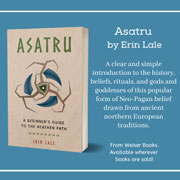If we can trust the parallels with later Classical art, this “Minoan” bulla (sealing) depicts the goddess known later as Kore (“Maiden”), or Persephone, rising from the Earth, assisted by a male figure, possibly a votary.
In the first century BCE, the Sicilian historian Diodorus wrote that the famous Eleusinian Mysteries had their origin in Crete where, however, they were performed quite publicly and without the secrecy that characterized the later Mysteries (Kerényi 24). We don't know where or from whom he got this information, but if the bulla shown above can be taken as evidence, it would certainly lend support to his theory.
Unfortunately, this bulla, with all its Minoan charm, is in all likelihood a forgery.
Our Kore Rising bulla was supposedly found, along with a trove of other “Minoan” sealings, near Thisbe in Boeotia, in mainland Greece, in the early years of the so-called 20th century. Interestingly—unlike virtually any provenanced Minoan seals—a number of them seem to depict recognizable episodes from Greek mythology. One particularly striking one depicts what is clearly Oedipus talking with the Sphinx, rather charmingly rendered as a Minoan-style griffin.
You know the saying: When something seems too good to be true, it probably is.
(Following Evans, early Minoanists tended to interpret Minoan culture through the prism of Classical mythology, but more recent scholarship suggests instead that comparing Minoan culture with other contemporaneous Mediterranean cultures may offer a less potentially distorting hermeneutic.)
In fact, as Kenneth Lapatin recounts in his 2002 Mysteries of the Snake Goddess, Arthur Evans had barely started excavating at Knossos in 1900 when Minoan fakes began to appear on the market. Everybody wanted a piece of Minoan Crete and, as usual, the market was more than happy to provide them, genuine or not. The Thisbe trove of seals and sealings would seem to be an example of the latter.
Recent archaeology has not been kind to Diodorus' claimed Cretan origins for the Mysteries of the Grain Mother and the Nameless Bride. In Michael B. Cosmopoulos' 2015 study of the excavation history of the Mystery Sanctuary at Eleusis, he cites “a total absence of Minoan imports or even influences at Eleusis during the Bronze Age,” the period during which the sanctuary was founded (Cosmopoulos 156); he concludes that the Mysteries were, in all likelihood, an indigenous local development.
Well. As I write this, here in the North Country, the sugaring is well underway, as sap rises in the trees. Through the coming days, we will actually watch the Rising occur: first the grasses will green, then the bushes leaf out, and lastly the trees open their buds.





















